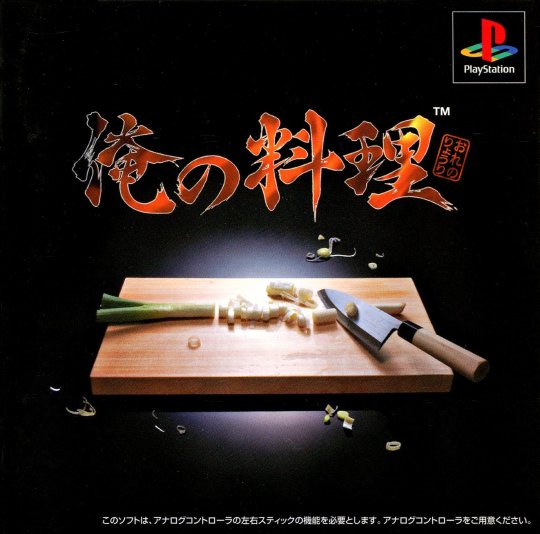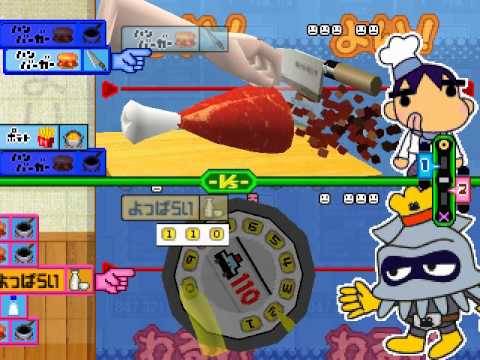#ore no ryouri
Text



15 notes
·
View notes
Text
Ore no Ryouri (I'm the Chef)
Argent - PlayStation - 1999

[images from giant bomb, youtube, and emuparadise]
it's very satisfying when the controls for a game feel immersive. it's like using a fishing controller for a fishing game like Sega Bass Fishing, or a light gun for a shooting game like House of the Dead, or the Wii remote for the swordfights in Wii Sports Resort. not a lot of games go for that, and I think that's kind of a shame. one of the most high-action and unique of this kind of game is Ore no Ryouri (which literally means I'm the Chef), a super snappy and arcade-y cooking/restaurant sim for the PS1 developed by Argent (which I can't find any information about at all, if anyone has any please message me). it doesn't use any special controller, only gestures on the Dualshock controller's two joysticks to give you the feeling of cooking: using the left stick to tilt a glass and the right stick to pour beer, spinning a stick to stir batter, or pushing a stick back and forth to flip a patty in a pan. it's simple, but the responsiveness and mechanics around the gestures encourage you to cook as fast and hard as you can with its immersive controls, which is the real essence of the manic Ore no Ryouri.
sometimes when I hear about a game that started a genre, I wonder how good it can actually be compared to the modern alternatives. I haven't heard of any cooking games that came before Ore no Ryouri (message me if I'm wrong) and there have been plenty of cooking games since 1999, like Cooking Mama, the Papa's series, and Cook, Serve, Delicious!, so there's been some time for someone to make something better than the first one. "better" and "best" are matters of opinion, but I still think Ore no Ryouri is easily the best and wholly unique among cooking games and games that aim to have "immersive" controls.

Ore no Ryouri works like this: customers' orders pop up on a list and their patience drains over time, always visible at the side of the screen. different dishes are broken down into different steps, and each step is a different gesture with the sticks. how fast and accurate you are on each step in a dish determines your final score when you finally serve it, so you want to work fast and well -- many steps let you perform literally as fast as you can move the joysticks, which makes it as intense as you want it to be. sometimes you have to wait for something to boil or fry, and you can work on different orders during those waiting steps, though you have to be sure to take it off the stove at the right time. and occasionally there are "problem tasks" that show up and take a little more time to do, like washing dishes or chasing a runaway customer. if you let the time on one of these run out, all your customers instantly leave, which is almost a guaranteed loss. when your score is high enough, you win. that's basically it.
it's also got a really quirky story that I can't read because I don't know Japanese and a bright, fun art style indicative of a Japanese PS1 game. there's an awesome competitive mode where two players can go head to head in an intense culinary tug-of-war, which I've mostly only played against computers because that's the story mode and no one else has ever played this. but still. by the way, the disc looks like this!
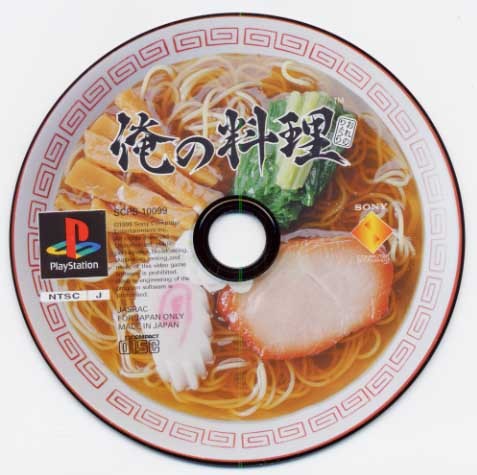
what I love about Ore no Ryouri is that it's ultra-responsive: it lets you go as fast as your hands and mind can take you. sometimes you have to wait for things to cook, but that's the time between, and even those few seconds of pause are important. if you take a long task at the wrong time, you might let burgers cook too long or let a customer get impatient and leave. balancing this just right and cooking as fast as you can with its odd immersive controls feels like nothing else. Cooking Mama is actually a great counter-example of responsiveness, since the minigames have lots of fanfare and tutorials between them and a simple dish can take a couple minutes start to finish, while Ore no Ryouri's long dishes take maybe 30 seconds. (Ore no Ryouri's tutorials are found during the "restaurant phase" of the sotry mode, where they show you the gestures you're supposed to do in the corner of the screen. the number of different gestures is also fairly limited, which is either for technical reasons or by design because it's hard to remember too many. either way, it feels great for its short runtime, though I wish there was more!)
by the way, cooking game fans probably already know Cook, Serve, Delicious! (CSD from here on), which is also a cooking/restaurant sim with really similar mechanics to Ore no Ryouri…because it is Ore no Ryouri. or it was. the first CSD was actually the commercial release of a fangame called Ore no Ryomi 3, the third in a line of fanmade PC remakes of Ore no Ryouri. the CSD series has definitely expanded mechanically on the foundation of Ore no Ryouri in a lot of interesting ways, and it does its best to emulate the intensity…but I think it falls short. it's like Guitar Hero on a keyboard instead of a guitar. there's just no comparison, even if Ore no Ryouri isn't as mechanically rich in certain ways. CSD is purely button-based, regardless of whether you're on controller or keyboard, and it just doesn't feel right after playing Ore no Ryouri. any fans of CSD should surely go back and give this one a try.
0 notes
Photo
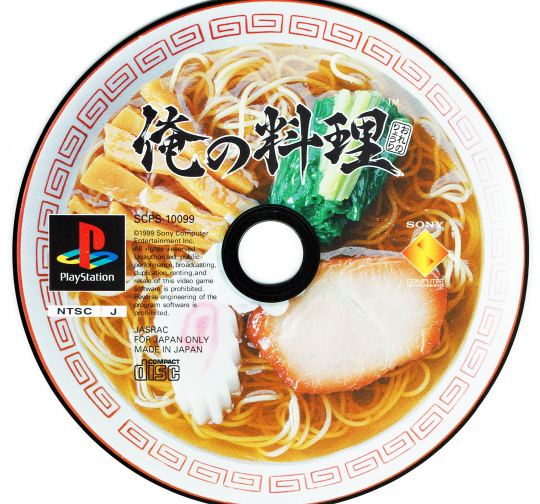

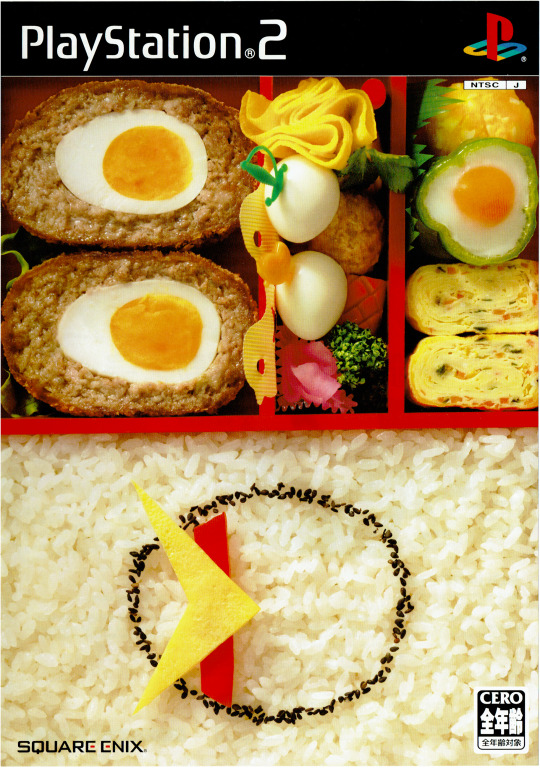



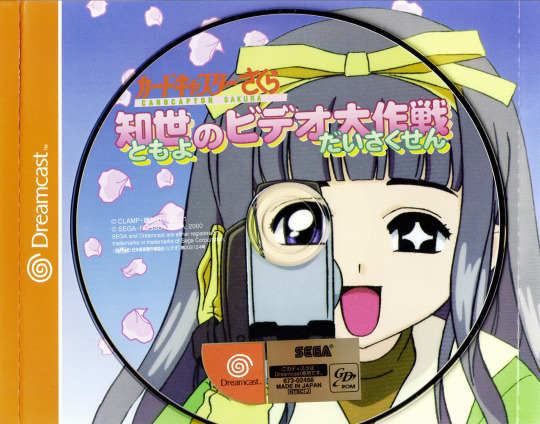
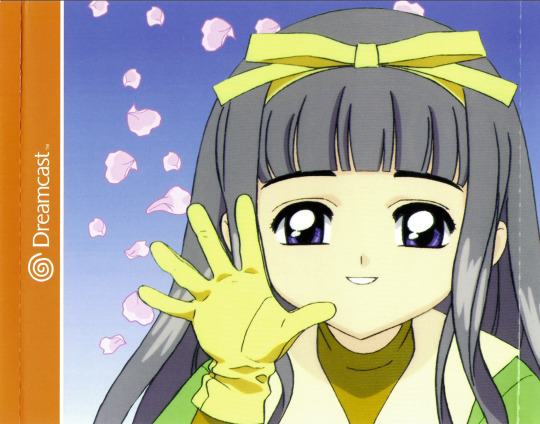
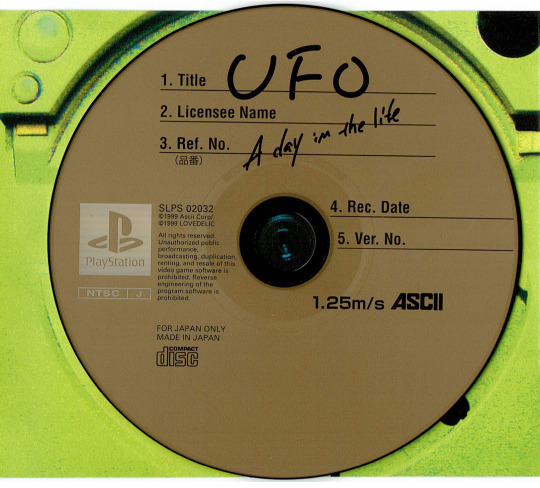
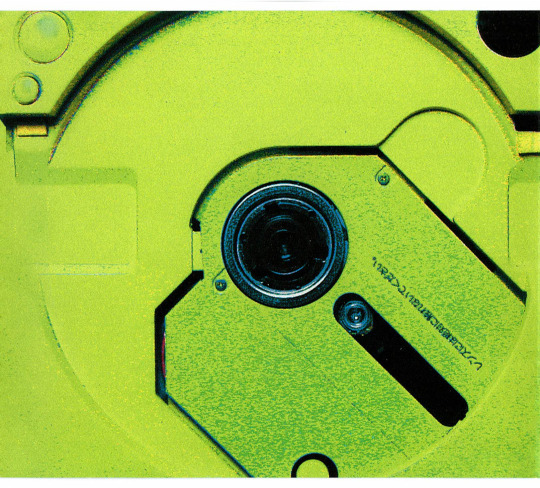
Visual narratives in Japanese game packaging: before and after.
Ramen: Ore no Ryouri - Argent, 1999
Bento: Hanjuku Eiyuu 4: 7-Nin no Hanjuku Eiyuu - Square Enix, 2005
Kincho: Ka 2 Rettsugō Hawai - Zoom, 2003
Shashin: Cardcaptor Sakura: Tomoyo no Video Daisakusen - SEGA, 2000
Eirian: UFO: A Day in the Life - Love-de-Lic, 1999
1K notes
·
View notes
Text
How to Use Gender-Neutral 3rd Person Pronouns in Japanese:
Note: I am not a native Japanese speaker, and I only have a conversational level in Japanese, as opposed to a fluent level. As such, please don't take anything I say as gospel.
Japanese pronouns are an open class of words in Japanese, rather than a closed class of words like they are in English. While that doesn't mean one can do anything one wants with pronouns in Japanese, it does mean one can mess around with them quite a lot. Pronouns are much less restrictive in Japanese than they are in English. One reason for this is that they don't decline. For example, 私 watashi covers I, me, my and mine, and how its case is decided is dependent on the particle that follows it.
私は watashi wa / 私が watashi ga = I (nominative)
私を watashi wo = me (accusative)
私に watashi ni = me (dative)
私と watashi to / 私から watashi kara = me (ablative)
私の watashi no = my / mine (genitive)
Another reason pronouns are more of an open class in Japanese is because they can often be dropped. In fact, Japanese sentences can often sound downright wrong if you don't omit certain pronouns.
* 「私の名前はニックです。」
^ "Watashi no namae wa Nikku desu." (awkward)
* 「名前はニックです。」
^ "Namae wa Nikku desu." (natural)
(= "My name is Nic.")
* 「私のネコは私が大好きです。」
^ "Watashi no neko wa watashi ga daisuki desu." (awkward)
* 「ネコは私が大好きです。」
^ "Neko wa watashi ga daisuki desu." (natural)
(= "My cat loves me.")
* 「あなたのネコはかわいいです。」
^ "Anata no neko wa kawaii desu." (awkward and borderline rude)[1]
* 「ネコはかわいいです。」
^ "Neko wa kawaii desu." (natural)
(= "Your cat is cute.")
* 「あの人はここに来てもいい。」
^ "Ano hito wa koko ni kitemo ii desu." (awkward sometimes)[2]
* 「ここに来てもいい。」
^ "Koko ni kitemo ii desu." (natural)
(= "He/She can come here.")
[1] Calling someone あなた anata in polite speech is usually considered very disrespectful. It's recommended to instead use a person's name with a polite honorific, with さん -san being the safest option.
[2] This is only awkward if the topic has already been established. For example, it would be awkward if the sentence followed something like this:
* 「あの人はあそこにいる。」
^ "Ano hito wa asoko ni iru."
(= "He/She is over there.")
Once the topic has been established, it's usually good to drop the topic upon repetition until a new topic is introduced. For instance:
* 「この人は友達です。アダムと言います。アメリカから来て、30歳です。趣味はカラオケと料理です。1年くらい���じています。大事なカンパニーのメンバーだと思います。」
^ "Kono hito wa tomodachi desu. Adamu to iimasu. Amerika kara kite, sanjuu-sai desu. Shumi wa karaoke to ryouri desu. Ichi-nen kurai sonjite imasu. Daiji na kanpanii no menbaa da to omoimasu."
(= "This person is my friend. He is called Adam. He comes from America, and he is 30 years old. His hobbies are karaoke and cooking. He and I have been acquainted for about 1 year. I think he will be an important member of the company.")
Because pronouns are open class in Japanese, they're very flexible. It's quite easy to mix and match pronouns in Japanese. This is one reason why a lot of Japanese media has casts who use different 1st person pronouns. For example, in the Japanese version of Paper Mario, マリオストーリー Mario Story, every Partner who joins Mario uses a different 1st person pronoun:
Kurio (Goombario): オイラ oira
Kameki (Kooper): オレッチ orecchi
Pinkie (Bombette): あたい atai
Paretta (Parakarry): わたし watashi
Resaresa (Bow): あたくし atakushi
Akarin (Watt): あたち atachi
Opuku (Sushie): あたしゃ atasha
Pokopie (Lakilester): オレ ore
This helps flesh them out and gives them all distinctive characteristics.
Now, let's talk about 3rd person pronouns in Japanese. In Japanese, the two binary pronouns are 彼 kare (he) and 彼女 kanojo (she). They're not actually used that often, but they're still good to know, especially since many English-written guides for learning Japanese make liberal use of these two pronouns.
* 「彼は男ですから、「僕」や「俺」などの一人称代名詞を使うことが好きです。」
^ "Kare wa otoko desu kara, "boku" ya "ore" nado no ichi-nin shou daimeishi wo tsukau koto ga suki desu."
(= "He is a man, and so likes using first-person pronouns like "boku" and "ore."")
* 「彼女は女ですから、「あたし」や「あたい」などの一人称代名詞を使うことが好きです。」
^ "Kanojo wa onna desu kara, "atashi" ya "atai" nado no ichi-nin shou daimeishi wo tsukau koto ga suki desu."
(= "She is a woman, and so likes using first-person pronouns like "atashi" and "atai."")
(Note that 彼 kare and 彼女 kanojo can also mean boyfriend and girlfriend respectively, though ボーイフレンド booifurendo, ガールフレンド gaarufurendo and パートナー paatonaa, all borrowed from English, are more commonly used these days.)
Here's the problem: 彼 kare and 彼女 kanojo form their plurals by adding ら -ra to the pronoun. You would use 彼ら kare-ra when referring to more than one person if the people are all male or there is at least one male in the group, and you would use 彼女ら kanojo-ra only if all the people being referred to are female. So, Japanese has a similar dilemma to French and Spanish, because they is gendered.
Except, in Japanese, there are a ton of gender-neutral pronouns you can use to refer to a single person. Some linguists even argue that Japanese doesn't technically have pronouns, as pronouns in Japanese work a lot more like glorified nouns.
To get an idea of the gender-neutral pronouns in Japanese, it's good to have some knowledge of how the こそあど言葉 ko-so-a-do words work. To be brief, こ ko, そ so, あ a and ど do are special morphemes that indicate position. Simply put, こ ko refers to something close to the speaker, そ so refers to something close to the listener, あ a refers to something close to neither or to something extract, and ど do refers to something interrogative.
Through this system, こ ko, そ so and あ a can be used to create various 3rd person pronouns, while do ど can be used to create various interrogative pronouns, like who and what. I won't talk about the interrogative pronouns here, because I feel that will clog up the post, but I will absolutely be talking about all the equivalents Japanese has for the singular they.
1: kochira, sochira, achira (こちら,そちら,あちら):
This is one of the safer ways to refer to people. These words literally translate to this way, that way and that way over there, relating to direction. They're more vague ways of referring to direction than ここ koko, そこ soko and あそこ asoko, which indicate an exact direction but can't be used as pronouns.
They are used to:
1) indicate a direction
* 「こちらにあると思う。」
^ "Kochira ni aru to omou."
(= "I think it's here.")
* 「ええ、本当に?そちらに置いたから。」
^ "Ee, hontou ni? Sochira ni oita kara."
(= "Huh, really? Because I put it there.")
* 「そう言えば、あちらにあるかもしれない。」
^ "Sou ieba, achira ni aru ka mo shirenai."
(= "Now that you mention it, it might be over there.")
2) refer to people in the 1st person (こちら kochira) or the 2nd person (そちら sochira)
* 「そちらとパーティーに行けて、とても嬉しかったです。」
^ "Sochira to paatii ni ikete, totemo ureshikatta desu."
(= "I was very happy to be able to go to the party with you.")
* 「こちらこそ。」
^ "Kochira koso."
(= "Me too.")
3) refer to people in the 3rd person
* 「こちらは内のクラスを混ざる。」
^ "Kochira wa uchi no kurasu wo mazaru."
(= "He/She/They is going to join our class.")
* 「そちらは私の親友だもん。」
^ "Sochira wa watashi no shin'yuu da mon."
(= "He/She/They is my best friend, of course.")
* 「私とあちらが仲よくない。」
^ "Watashi to achira ga naka yokunai."
(= "He/She/They and I don't get along.")
When used as 3rd person pronouns, こちら kochira and そちら sochira can typically only be used to refer to someone who is present, while あちら achira can be used to refer to someone who is either present or absent.
These words cannot be made plural, although they can be interpreted as plural depending on context.
2: koitsu, soitsu, aitsu (こいつ,そいつ,あいつ):
This is not a safe way to refer to someone if you don't know what you're doing. It literally translates to this guy, that guy and that guy over there, with the guy being gender-neutral the same way you guys is in English. It's often used by men rather than women, as it's considered quite "un-ladylike," though women can use it. It's used to refer objects, or to people who are of equal or inferior social standing to the speaker, such as friends or children. It can have a rude or hostile edge to it in some contexts.
They are used to:
1) indicate an object
* 「こいつがほしい!」
^ "Koitsu ga hoshii!"
(= "I want this one!")
* 「そいつを貰う!」
^ "Soitsu wo morau!"
(= "I'll take that one!")
* 「それじゃ、私はあいつを買わなきゃ!」
^ "Sore ja, watashi wa aitsu wo kawanakya!"
(= "Then I've just gotta buy that one over there!")
2) indicate a person or animal:
* 「こいつは友達だ。」
^ "Koitsu wa tomodachi da."
(= "He/She/They is a friend.")
* 「そいつ、歌うのは上手だな。」
^ "Soitsu, utau no wa jouzu da na."
(= "He/She/They is good at singing.")
* 「さっき、公園にあいつを会った。」
^ "Sakki, kouen ni aitsu wo atta."
(= "I met him/her/them in the park earlier.")
To make any of these pronouns plural, simply add ら -ra to their end, or add たち -tachi to their end.
3: kono yatsu, sono yatsu, ano yatsu (この奴,その奴,あの奴):
This means the same thing and work exactly the same way as こいつ koitsu, そいつ soitsu and あいつ aitsu. In fact, こいつ koitsu, そいつ soitsu and あいつ aitsu come from この奴 kono yatsu, その奴 sono yatsu and あの奴 ano yatsu. Before that, though, they entered a "transitional phase" and became こやつ koyatsu, そやつ soyatsu and あやつ ayatsu. Those are archaic now, but このやつ kono yatsu, そのやつ sono yatsu and あのやつ ano yatsu are occasionally used instead of こいつ koitsu, そいつ soitsu or あいつ aitsu, usually for emphasis.
They are used to:
1) indicate an object
* 「この奴が最高のゲームだ。」
^ "Kono yatsu ga saikou no geemu da."
(= "This one is the best game.")
* 「その奴のエンジンは壊れたと思う。」
^ "Sono yatsu no enjin wa kowareta to omou."
(= "I think that one's engine is broken.")
* 「私、あの奴が聞こえる。」
^ "Watashi, ano yatsu ga kikoeru."
(= "I can hear that one over there.")
2) indicate a person or animal:
* 「このやつは悔しすぎる!」
^ "Kono yatsu wa kuyashisugiru!"
(= "He/She/They is too frustrating!")
* 「みんなはそのやつが好きだ。」
^ "Minna wa sono yatsu ga suki da."
(= "Everyone likes him/her/them.")
* 「あのやつ、本当に最低だな。」
^ "Ano yatsu, hontou ni saitei da na."
(= "He/She/They is really the worst.")
Like こいつ koitsu, そいつ soitsu and あいつ aitsu, simply add ら -ra to make the pronouns plural, or add たち -tachi.
4: kono kata, sono kata, ano kata (この方,その方,あの方):
This is the absolute most polite way you can refer to someone. This is generally how you'd refer to a superior, such as your boss, or, in some cases, someone you really admire. It's made by combining この kono, その sono or あの ano with 方 kata, a respectful word for person.
* 「この方は私の上司です。」
^ "Kono kata wa watashi no joushi desu."
(= "He/She/They is my boss.")
* 「私、その方に「すばらしい料理人です」と伝えた。」
^ "Watashi, sono kata ni, "subarasbii ryouri-nin desu" to tsutaeta."
(= "I told him/her/them, "You're an amazing cook."")
* 「私はついにあの方を会えた!」
^ "Watashi wa tsui ni ano kata wo aeta!"
(= "I was finally able to meet him/her/them!")
To make these pronouns plural, add 々 -gata to the end of the word. You can also make these words plural by adding たち -tachi to the end of the word, though this is slightly less polite.
5: kono hito, sono hito, ano hito (この人,その人,あの人):
This is a safe way to refer to someone, because it can be both polite and informal. Thus, you're unlikely to offend anyone by using this. It's made by combining この kono, その sono or あの ano with 人 hito, which is the standard word for person.
* 「この人の一番好きな動物はネコだもん。」
^ "Kono hito no ichi-ban suki na doubutsu wa neko da mon."
(= "His/Her/Their favorite animal is cats, of course.")
* 「その人はコンピュータゲームが大好きだ。」
^ "Sono hito wa konpyuuta geemu ga daisuki da."
(= "He/She/They loves video games.")
* 「昨日、あの人と話した。」
^ "Kinou, ano hito to hanashita."
(= "I spoke with him/her/them yesterday.")
There two says to make these pronouns plural. The first is to add 々 -bito to the end of the word, and the second is to add たち -tachi to the end of the word. Both are pretty safe.
6: kono ko, sono ko, ano ko (この子,その子,あの子):
This, in a way, is the "feminine" equivalent of こいつ koitsu, そいつ soitsu and あいつ aitsu. It's used to refer to people your own age or younger, so it's informal. Generally, guys won't use this for other guys, but they will use it for girls, and girls will call guys and other girls this. It's made by combining この kono, その sono or あの ano with 子 ko, which means child or kid.
* 「この子は何をしてるの?」
^ "Kono ko wa nani wo shite'ru no?"
(= "What's he/she/they doing?")
* 「その子の新しいラジオは高い。」
^ "Sono ko no atarashii rajio ga takai."
(= "His/Her/Their new radio is expensive.")
* 「私、あの子にプレゼントをあげた。」
^ "Watashi, ano ko ni purezento wo ageta."
(= "I gave him/her/them a present.")
To make these pronouns plural, add たち -tachi to the end of the word.
7: kono gaki, sono gaki, ano gaki (このガキ,そのガキ,あのガキ):
You shouldn't use this to refer to someone unless they're your age or younger, and you're either very close to them or want to insult them. It's made by combining この kono, その sono or あの ano with ガキ gaki, which literally means brat.
* 「このガキはいい仲間 だ けど…」
^ "Kono gaki wa ii nakama da kedo..."
(= "He/She/They is a good friend, but...")
* 「兄さんはそのガキが好きじゃない。」
^ "Nii san wa sono gaki ga suki ja nai."
(= "My brother doesn't like him/her/them.")
* 「あのガキの先生厳しいな!」
^ "Ano gaki no sensei wa kibishii na!"
(= "His/Her/Their teacher is so strict!")
To make these plural, add either ら -ra or たち -tachi to the end of the word.
8: kono yarou, sono yarou, ano yarou (このヤロウ,そのヤロウ,あのヤロウ):
This one is a big no-no unless you're very close with a person your age or younger, or if you want to offend the hell out of someone. It's made by combining この kono, その sono or あの ano with ヤロウ yarou, which literally translates to bastard or, if you're generous, rascal.
* 「このヤロウはビールを盗んだ!」
^ "Kono yarou wa biiru wo nusunda!"
(= "He/She/They stole the beer!")
* 「私、そのヤロウの声が別に好きじゃない。」
^ "Watashi, sono yarou no koe ga betsu ni suki ja nai."
(= "I don't really like his/her/their voice.")
* 「あのヤロウが全然分かれない!」
^ "Ano yarou ga zenzen wakarenai!"
(= "I can't understand him/her/them at all!")
If you want to make the words plural, add ら -ra or たち -tachi to their ends.
9: kore, sore, are (これ,それ,あれ):
This is basically the equivalent of calling someone it. I know some people prefer that, so I thought I'd include these words, which actually translate to this one, that one and that one over there, because Japanese doesn't have a direct word for it. As usual, you probably shouldn't use this for someone, especially if they're older than you, unless they specifically request it or you want to insult them.
They are used to:
1) indicate an object
* 「これは私のリンゴだ。」
^ "Kore wa watashi no ringo da."
(= "This one is my apple.")
* 「私、それを買いたい。」
^ "Watashi, sore wo kaitai."
(= "I want to buy that one.")
* 「あれがネコのボールだ。」
^ "Are ga neko no booru da."
(= "That one over there is the cat's ball.")
2) indicate a person or animal:
* 「私、これに行きたい。」
^ "Watashi, kore ni ikitai."
(= "I want to go with it.")
* 「それは面白い人だ。」
^ "Sore wa omoshiroi hito da."
(= "It is an interesting person.")
* 「あれは音楽が上手だ。」
^ "Are wa ongaku ga jouzu da."
(= "It is good at music.")
As far as I know, these words can't be made plural, but they can be plural in meaning sometimes, depending on context.
How to politely request to be referred to a certain way in Japanese:
To wrap up this post, here's how to politely request to be referred to with a particular pronoun in Japanese. I included the Japanese equivalents for he, she, they and it.
1)
* 「私の優先の人称代名詞は「彼」です。
^ "Watashi no yuusen no ninshou daimeishi wa "kare" desu."
(= "My preferred personal pronoun is "he."")
* 「私の優先の人称代名詞は「彼女」です。」
^ "Watashi no yuusen no ninshou daimeishi wa "kanojo" desu."
(= "My preferred personal pronoun is "she."")
* 「私の優先の人称代名詞は「あの人」です。」
^ "Watashi no yuusen no ninshou daimeishi wa "ano hito" desu."
(= "My preferred personal pronoun is "they."")
* 「私の優先の人称代名詞は「あれ」です。」
^ "Watashi no yuusen no ninshou daimeishi wa "are" desu."
(= "My preferred personal pronoun is "it."")
2)
* 「私は「彼」と呼ぶことが好きです。」
^ "Watashi wa "kare" to yobu koto ga suki desu."
(= "I like to be called "he."")
* 「私は「彼女」と呼ぶことが好きです。」
^ "Watashi wa "kanojo" to yobu koto ga suki desu."
(= "I like to be called "she."")
* 「私は「あの人」と呼ぶことが好きです。」
^ "Watashi wa "ano hito" to yobu koto ga suki desu."
(= "I like to be called "they."")
* 「私は「あれ」と呼ぶことが好きです。」
^ "Watashi wa "are" to yobu koto ga suki desu."
(= "I like to be called "it."")
3)
* 「私に「彼」と呼んでください。」
^ "Watashi ni "kare" to yonde kudasai."
(= "Please call me "he."")
* 「私に「彼女」と呼んでください。」
^ "Watashi ni "kanojo" to yonde kudasai."
(= "Please call me "she."")
* 「私に「あの人」と呼んでください。」
^ "Watashi ni "ano hito" to yonde kudasai."
(= "Please call me "they."")
* 「私に「あれ」と呼んでください。」
^ "Watashi ni "are" to yonde kudasai."
(= "Please call me "it."")
4)
* 「私に「彼」と呼んでくださったら、とてもありがたいです。」
^ "Watashi ni "kare" to yonde kudasattara, totemo arigatai desu."
(= "If you could call me "he," I would be very grateful.")
* 「私に「彼女」と呼んでくださったら、とてもありがたいです。」
^ "Watashi ni "kanojo" to yonde kudasattara, totemo arigatai desu."
(= "If you could call me "she," I would be very grateful.")
* 「私に「あの人」と呼んでくださったら、とてもありがたいです。」
^ "Watashi ni "ano hito" to yonde kudasattara, totemo arigatai desu."
(= "If you could call me "they," I would be very grateful.")
* 「私に「あれ」と呼んでくださったら、とてもありがたいです。」
^ "Watashi ni "are" to yonde kudasattara, totemo arigatai desu."
(= "If you could call me "it," I would be very grateful.")
The ko-so-a-do chart for pronouns:

That’s all I’ve got for now. Thanks for reading. :)
3 notes
·
View notes
Text
Ore no Ryouri
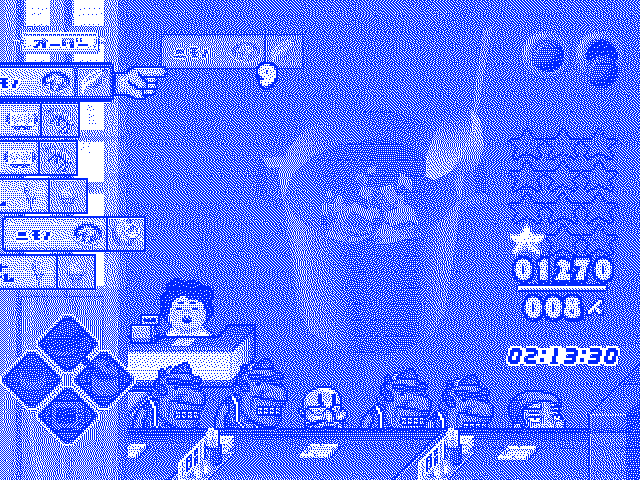
Anyone with an understanding of my gaming tastes will know I heavily value:
(1) Games with novel control schemes
(2) Games which were 'firsts'
(3) Games which are obscure
(4) Games with chores
(5) Games with cooking
Ore no Ryouri is a pitch-perfect example of all the above. The cherry on top is that it is simple enough to work despite a glaring language barrier.
From the outset, Ore no Ryouri operates as an alternate take on Ape Escape's intent for the DualShock. The analog stick-centric gameplay highlights the possibilities afforded by the DualShock as a more direct and intuitive mode of player action. Whereas Ape Escape demonstrated movement alongside use of a tool, Ore no Ryouri opts for effectively mapping each arm/hand to a stick. When preparing soft serve ice cream, one stick controls the flow, the other swirls the cone. Pouring a beer involves tipping the glass and pulling the tap. Cutting means moving your stabilising hand in conjunction with your chops. Shaping a patty has your hands moving in tandem. Of course, not every kitchen task is an ambidextrous affair; ladling, salting, sauteing, etc. are done one handed. The act of turning on a fryer or burner is a simple button.
Ore no Ryouri doesn't needlessly complicate its gameplay for the sake of complexity. If anything, it seeks to reduce the involvement required for kitchen tasks. When multiples of the same ticket item are ready for frying, for example, they all get placed in the fryer at once. Pouring condiments is much the same, as is pouring broth to finish a bowl of ramen. This reduces the anxiety of the balancing act as tickets run out their respective timers, but also allows for combos by completing batches of tickets at once. Five orders of fries are fried, salted, and served as one, racking up huge points and setting the player up for stage completion or success in a cook-off.
The chores are damn great as well. Smashing roaches, dialing a rotary phone, counting money, and scrubbing dishes are all clever uses of dual analog, the latter in particular striking my fancy. A very similar dish washing chore exists in another favourite franchise of mine, Cook, Serve, Delicious! The similarity was so incredible to me that I did some quick searching and found out Vertigo Gaming's earliest projects were flash remakes of Ore no Ryouri, eventually becoming the CSD series. The feeling of Ore no Ryouri being a proto-CSD is not mere coincidence, it is a delightful truth. The transition of dual analog to a keyboard and mouse setup (and later, controller support) was elegant for that series, but I am somewhat wistful as to what CSD could be if it adhered more strictly to Ore no Ryouri's maximalism of the DualShock. Thankfully, what footage we've seen thus far of Cook Serve Forever seems to suggest it is leaning more heavily into that deliberate control rather than typing gameplay. In that sense, Ore no Ryouri has accomplished that which I wanted from Ape Escape by influencing contemporary games decades after showcasing the possibilities of play and control.
Bon appétit!
0 notes
Note
("Ooi, Supein! Kotoshi mo tomato ga takusan toreta zo, 'kkono yaro!")
Buono! Tomato buono Tomato
Buono buono uu! Tomato
Aka agete midori sagete!?
Toma- toma- tomato, Hn♪
Pasta ni wa tomato daro
Pizza ni mo tomato daro
Miwaku no akai tesoro
Tomato daisuki
Demo
Wurst ya jagaimo nanka jadou da
Otouto mo tabedashite muki- muki- muki- mu
Napolitan wa nihon ryouri nanda, kono yaro!
"Hyaaaa!
France da! Mamore! Kon-chikushou me!!"
("Hitori ni suru na yo kono yaro...")
Kimi ni mo hitotsu ageru
Kireina no hitotsu ageru
Oishii tomato tabete
Boku to odorou
(Amore!)
Buono! Tomato buono Tomato
Buono buono uu! Tomato
Ci vediamo a Romano
Minami Itaria☆
("Aa...onaka suita zo! Souji owan'nee na...!")
Buono! Tomato buono Tomato
Buono buono oo! Tomato!
Aka sagete midori agete!?
Toma- toma- tomato, Hn♪
Supein ga motte kita
Amerika kara motte kita
Taiyou no kuni no tesoro
Tomato daisuki
Demo
Ai wa katareba ii tte mon jyanai zo
Wain katate ni itsumo gira- gira- gira- gi
Sakki kawaii ko ni mushi sareta zo kono yaro!
"HYAAAAAAA!!!
Chikushou!! Itsumo ore bakkari nerai yagatte!"
("Supein no yaro, tasuke ni koi yo...!")
Buono! Tomato buono Tomato
Buono buono uu! Tomato!
Chichukai mo o sore mio
Minami Itaria☆
Kaji wa anmari kiyou jyanai kedo
Otouto no ga e ya boueki tokui dakeredo
Tama ni tori ni made baka ni sareru kedo
Ore datte...! Ore datte...! CHIGIIIIIIII---!!!
Buono! Tomato buono Tomato
Buono buono uu! Tomato
(Buono! Tomato buono Tomato
Buono buono uu! Tomato)
Buono! Tomato buono Tomato
Buono buono uu! Tomato!
(Buono! Tomato buono Tomato)
Uno・Due・Tre・dai!
Kimi ni mo hitotsu ageru
Kireina no hitotsu ageru
Oishii tomato tabete
Boku to odorou
(Amore!)
Buono! Tomato buono Tomato
Buono buono uu! Tomato!
Ci vediamo a Romano
Minami Itaria☆
fr
0 notes
Photo


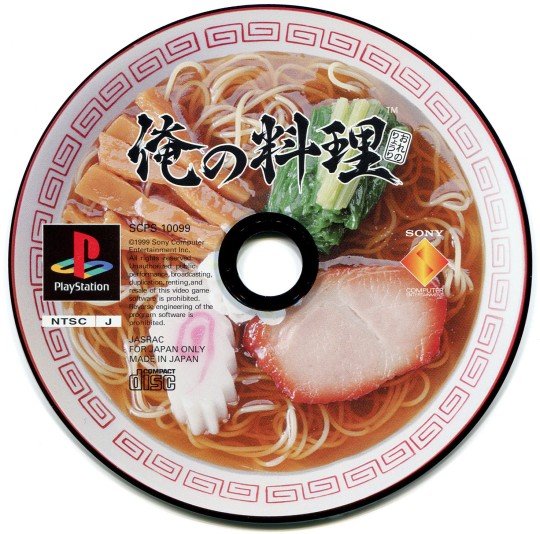

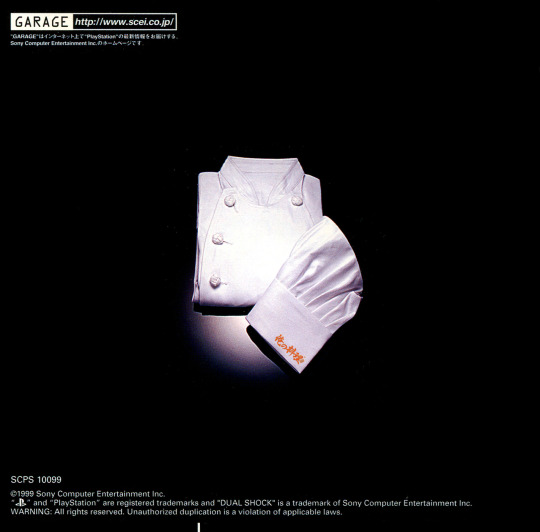
From: Ore no Ryouri (俺の料理)
662 notes
·
View notes
Text
CHiCO with HoneyWorks — LOVE FIGHT [English Translation]

「好きなことは好きなだけ」これが俺のスタイル
笑うやつは黙ってろ
ボディ・ジャブ・ストレート
“Suki na koto wa suki na dake” kore ga ore no sutairu
Warau yatsu wa damattero
Bodi. jabu. sutoreeto
'Do what you like, as much as you like', that's my style.
If you laugh at me, shut up!
Body jab straight*
君に似合うメイク、ファッション、ネイル
料理も任せてね教えてあげる
流行りもチェック済み 君に共有
可愛くしてあげちゃう 妄想ファッションショー
Kimi ni niau meiku, fasshon, neiru
Ryouri mo makasete ne oshiete ageru
Hayari mo chekku zumi kimi ni kyouyuu
Kawaiku shite agechau mousou fasshon shoo
I'll teach you how to make up, fashion and nail polish to suit you
I'll cook for you, I'll teach you
I've seen what's in style I'll share it with you
I'm going to make you so pretty I'm going to put on a fashion show
弟みたいだって思ってる?
その仕草もその表情も
LiKE or LOVE?
俺だって男だよ
Otouto mitai datte omotteru?
Sono shigusa mo sono hyoujou mo
LiKE or LOVE?
Ore datte otoko da yo
Do you think I'm like your brother?
The way you act, the way you look
LiKE or LOVE?
I'm a man too!
「好きなことは好きなだけ」これが俺のスタイル
欲しいものは欲しいだけ 君の笑顔とハート
反則級の可愛さ 俺以外には見せないで
君狙うやつ見過ごせない 暴れちゃうの許して♡
ボディ・ジャブ・ストレート
“Suki na koto wa suki na dake” kore ga ore no sutairu
Hoshii mono wa hoshii dake kimi no egao to haato
Hansokukyuu no kawaisa ore igai ni wa misenaide
Kimi nerau yatsu misugosenai abarechau no yurushite♡
Bodi. jabu. sutoreeto
What I like, I like only, this is my style
All I want is what I want, your smile and your heart
You're so cute, you're a foul play
I don't want to miss anyone who's out to get you.
Body, jab, straight
あの頃は勇気も自信もなくて
平気なフリをして 心閉ざして
そんな俺の心 溶かしてくれた
今が楽しいのは 君のおかげだよ
Ano koro wa yuuki mo jishin mo nakute
Heiki na furi wo shite kokoro tozashite
Sonna ore no kokoro tokashite kureta
Ima ga tanoshii no wa kimi no okage da yo
I don't have the courage or confidence back then
I'll pretend I'm fine, I'll keep my heart closed
You melted my heart
I'm happy now because of you
陰口言われたって関係ない
ぬいぐるみも お菓子作りも
LOVE and LOVE
好きは最強の武器
Kageguchi iwaretatte kankei nai
Nuigurumi mo okashi tsukuri mo
LOVE and LOVE
Suki wa saikyou no buki
I don't care if people talk about me behind my back
I love stuffed animals and making sweets
LOVE and LOVE
Love is the strongest weapon
「可愛い系 家庭的」これが俺のスタイル
昨日編んだマフラーは 君だけにプレゼント
反則級の強さで 今度は俺が守るから
君泣かすやつ見過ごせない こっそりトレーニング
レイズ・プレス・スクワット
“Kawaikei kateiteki” kore ga ore no sutairu
Kinou anda mafuraa wa kimi dake ni purezento
Hansokukyuu no tsuyosa de kondo wa ore ga mamoru kara
Kimi nakasu yatsu misugosenai kossori toreeningu
Reizu. puresu. sukuwatto
"Cute and homely" is my style
The scarf I knitted yesterday is a present only for you
I'll protect you this time with my foul strength
I can't overlook the ones that make you cry I'll train in secret
Raise press squats
弟みたいだって思ってる?
その仕草もその表情も
LiKE or LOVE?
俺だって男だよ
Otouto mitai datte omotteru?
Sono shigusa mo sono hyoujou mo
LiKE or LOVE?
Ore datte otoko da yo
Do you think I'm like your brother?
The way you act, the way you look
LiKE or LOVE?
I'm a man too!
幼馴染もいいけど そろそろ ねえ?
ドキドキしてほしいな ねえ 気づいて?
Osananajimi mo ii kedo sorosoro nee?
Dokidoki shite hoshii na nee kizuite?
I don't mind being your childhood friend, but it's time to move on.
I want you to be thrilled.
「好きなことは好きなだけ」これが俺のスタイル
欲しいものは欲しいだけ 君の笑顔とハート
反則級の可愛さ 俺以外には見せないで
君狙うやつ見過ごせない 暴れちゃうの許して
これが俺のスタイル
ボディ・ジャブ・ストレート
“Suki na koto wa suki na dake” kore ga ore no sutairu
Hoshii mono wa hoshii dake kimi no egao to haato
Hansokukyuu no kawaisa ore igai ni wa misenaide
Kimi nerau yatsu misugosenai abarechau no yurushite
Kore ga ore no sutairu
Bodi. jabu. sutoreeto
"Whatever you like, as much as you like," that's my style
All I want is what I want Your smile and your heart
I'm the only one who can see how cute you are
I don't want to miss the one who's after you Forgive me if I get out of control
That's my style
Body, jab, straight
body-jab - a punch in boxing (Shishihara-kun's crown punch)
6 notes
·
View notes
Video
youtube
OH MY GOSH!
I played this weird arse game on a demo disk at my grandparent’s house FOREVER ago and have been wondering what it is ever since. But as much as I searched, I could never find any information on it! I can't believe I've found it after all these years! I'm SOOO tickled right now! xD
0 notes
Audio
egetsunai
Letra y música: Ozakaki Taiikuu.
yossha koko kara ageteku Boruteeji
yahoo chou genki chou genki ni tenpenji
shippe Dekopin baba Choppu
teggyu kabe Don nage Kissu
Disqualifying foul wa shitakunai
seiseidoudou mashoumen kara kakan ni mukiae
aa da koo da yaiyai yakamashiwai
Wonderful da hora ittare Shibutani
Hey! Hey! koko made kaze kuru kurai ni aoi de mii!
Hey! Hey! Put your hands up in the air!
kore ga oretachi no henseifuu da kiryuu wo tsukande nottekoi
saikou de egetsunai moriagari I get tonight
kakattekoi yo nan datte sou sui mo Sweet mo
zein de egetsunai High Tension I get you now
hitofu de egaita futatsu no en wa daidanen ni natte rankiryuu wo koete yukunda
kare kore oretachi nannenme? sou iya kenka mo shitotta naa
kenka wo suru hodo nagai irashii yattaro ka? hona Biito kure
okke okke
toriaezu omaera sagare
tadaima yori Kanjani∞ Freestyle Rap Battle wo oimasu
mazu wa Ohkura Versus Yasuda
Yo! are? Yasu doko ikimashita?
aa soko ka suman miehenkatta
korokoro ka Town Peeji
ashimoto ni shiitaru ka korokoro
kamigata kaete bakkari de heya mo kitanai
"oshibori" no koto mo "teshibori" tte iushi
"chuuka ryouri tte nan ryouri"
to ka mou Nihongo mechakucha
subete ga chirakatteru amaenbo
jikka kara denaose ama e Go
oi Ohkura nanja
Ookora?
kare no okazu ni tendon tte nanyanen
itsumade tatte mo kui hatteru iji
tabemono no koto ni nattara Crazy
ore no kamigata maneshite kinpatsu ni shita koto atta kedo
an toki hometatte
ore dake ya
omae no Fansaa wa somosomo amai
Nishikido ya Shibuyan no Fansaa minarae
fudan naka no ii futari deshita ga
Bacchibachi no Batoru deshita
saa dondon ikimashou
tsuzuite no Batoru wa Shibutani Versus Yokoyama
"kyou wa sakenomanzo" tte iuta hi mo
ore ga sasottara sugu nomushi
wasuremonmo naorahen naa
Saunaa ikisugite nobasetenchau ka
menkyoshou no saihakkou wa nanakaime rougo ga shinpai
Have a nice day!
Dorama no genba de hitomishiri
eiga no genba de hitorikiri
iya iya iya
choi mate choi mate
hitomishiri wa omae ya
shito neta mo Pii! on de
Fan ni wa todoitenaku
Geemu wo Toire ni otoshite naku
ato kuehen kuse ni youke tanomu naa
ore ga nokorimon kautatten nen
shotaimen no hito no omae jya shizuka ni shiharu
omae no namae wa Shibutani Subaru
nenchoukumi no futari no niramiai
susamajii mono wo kanjimashita ne
saa iyo iyo
saigo no Batoru desu
Nishikido Versus Maruyama
furitsu machigau yopparatte Kisu ma
demo kojin no shigoto wa Kuuru Kyara?
jibun no heya ni jibun no Posutaa
hatteta jiten de itai yo na?
Paper driver
denwa kowai wa omae no joshuseki fuan ga ippai
ittai koto ga aru nara
oi nanka iu te mi Maruyama!
Yo! ano...
a... Ryochan...
omae wa sono...
oi Maru doushitennen?
iya... datte Ryochan kowainenmon
omae no kata toshiue yakara ittare!
iya ya! ore konnnan de
konnnan de kenka to kashitakunainen
ore minna de nakayokushitetai nen mo
datte orera mukashi kara zutto issho ni
yatte kitetan yanka
yakou Basu de nishi to higashi nankai mo oufukushita
Guriin ja no kippu haraimodoshite
uita karada de meshi katta
sou yatte tesaguri no mama mo ga ita
sore ga sore ga oretachi no keiken atai yaro?
oretachi jishin ga henseifuu da kiryuu wo tsukande nottekoi
saikou de egetsunai moriagari I get tonight
kakattekoi yo nan datte sou sui mo Sweet mo
zein de egetsunai High Tension I get you now
hitofu de egaita futatsu no en wa daidanen ni natte rankiryuu wo koete yukunda.
Kanji: Blog | LJ
12 notes
·
View notes
Text
Les tests : #2 - Ore No Ryouri (PS1)
Les tests : #2 – Ore No Ryouri (PS1)
Pour ce deuxième test, à vos fourneaux pour Ore No Ryouri (My Cooking) sur Playstation 1!
Suivez Retour vers le rétro (more…)
View On WordPress
0 notes
Photo
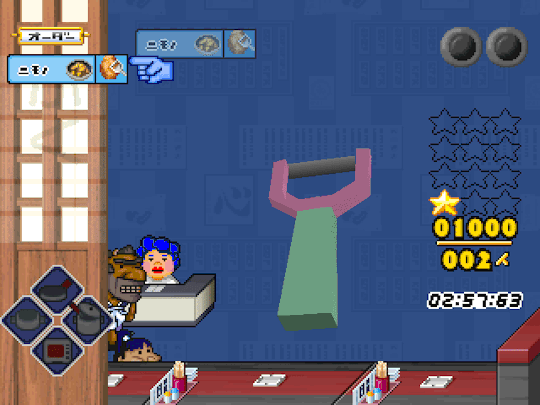

Ore no Ryouri // Stew (PS1 1999, Sony)
238 notes
·
View notes

